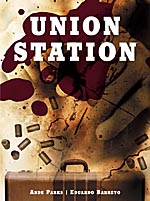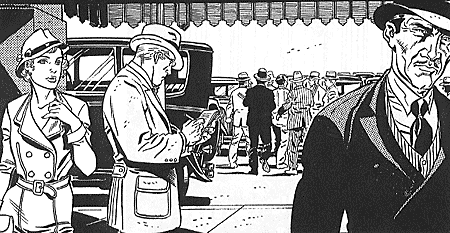 Written by Ande Parks
Written by Ande Parks
Art by Eduardo Barreto
120 pages, black and white
Published by Oni Press
The phrase “graphic novel” is one that’s thrown around comics a lot these days. Anyone and everyone is trying to produce graphic novels—but so often the end result feels like little more than a padded-out 32-page comic that the creators or publishers merely wanted to have a spine and ISBN number. I think that’s why I instantly appreciated Ande Parks’s and Eduardo Barreto’s Union Station so much, because it never lost sight of its goal to be an actual novel.
In June 1933, the bustling landmark of Kansas City’s Union Station was about to explode into violence. Criminal Frank Nash was being transferred there on his way to Leavenworth Prison, and the two Bureau of Investigation agents in charge of Nash had no idea of what was waiting for them. An attempt to free Nash was about to occur, and by the time it was over, several detectives and agents would be dead, a massive investigation into finding the shooters would be pending… and one reporter would know what really happened that day.
Parks’s usage of the real-life Kansas City Massacre in Union Station meant that he had to walk a very fine line. On the one hand, you can’t change history too much without knocking readers out of the story that already know what happened in Union Station that day. At the same time, though, Parks clearly wanted to put his own mark on the story and do more than a straight retelling of a historical event. Enter Charles Thompson, Parks’s journalist that tries to dig into what really happened at Union Station. It’s a nice touch in part because Parks doesn’t go for a central character, but more of an ensemble cast that all get their part in the spotlight. Thompson’s investigating may spur the actions of others, and it allows Parks to get into places that he wouldn’t otherwise, but he’s never so much in the center stage that it turns into a cliched mystery of a reporter trying to find the truth. This is a crime novel, and that means that we get to see what’s going on from all angles. Parks handles the viewpoints from real-life people like Vetterli and Gill just as well as the fictional ones, and paints a pretty convincing argument for what happened at Union Station. In the end, Parks takes the facts and then makes them tell the story he wants—without ever bending or breaking the reality of the situation into anything else.

Barreto is an artist who often gets pigeonholed as a “noir” comic artist, but looking at the finished product it’s easy to see why. Barreto excels at drawing the real world in a gritty manner, from the hard boiled expressions on the crooks’s faces to the slightly stiff yet seedy fashions of the 1930s. Many artists might chafe at the idea of drawing dozens of men in suit jackets and ties, but Barreto doesn’t just do what he’s asked for, he takes it several steps further. The world of Union Station comes to life thanks to Barreto’s depiction of the fashions and people of the era, looking instantly recognizable without jumping into the world of cliche. Most importantly, though, Barreto is able to take the big shoot-out at Union Station and make it both very clear on what has happened as well as very unclear as to the finer details. It’s a tough line to walk, but I think Barreto does it perfectly. You know the big picture perfectly, but it’s everything that needs to be filled in that Barreto carefully obscures. Good thing this is a book where you can stop and analyze every panel carefully.
Union Station is very much a full-fledge crime novel; it’s a sharp debut for Parks as a writer, as well as a welcome addition of Barreto to the world of Oni Press. With the strength of Queen & Country and One Plus One, Union Station is in fine company at Oni, but more importantly it’ll make fine company on your bookshelf. Just don’t bury it behind something else, because Union Station is the sort of book you’ll want to read again and again as you get more out of it with each reading. Now that’s the hallmark of a good novel.
Purchase Links:
